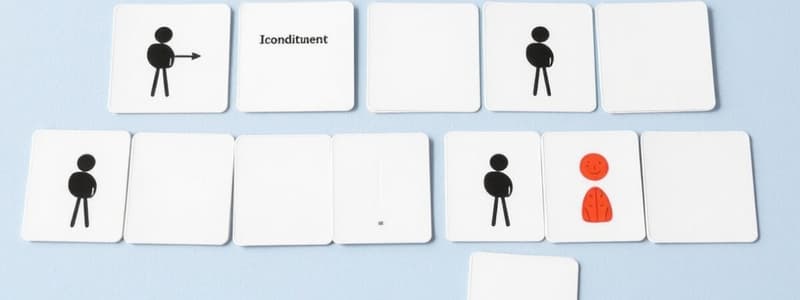Podcast
Questions and Answers
Sal's dog acts excited when Sal puts on his tennis shoes. His dog's behavior is a __________.
Sal's dog acts excited when Sal puts on his tennis shoes. His dog's behavior is a __________.
conditioned response
In a conditioning experiment, which of the following statements is true regarding the puff of air?
In a conditioning experiment, which of the following statements is true regarding the puff of air?
- The sound is paired with the puff of air. (correct)
- The puff of air is the conditioned stimulus.
- The rabbit blinks before hearing the sound.
- The puff is no longer effective after several pairings.
In John Watson's experiment with Little Albert, the white rat served as the ________ stimulus.
In John Watson's experiment with Little Albert, the white rat served as the ________ stimulus.
conditioned
Watson's experiment with Little Albert demonstrated that fears might be __________.
Watson's experiment with Little Albert demonstrated that fears might be __________.
In Pavlov's studies, conditioning dogs to salivate to specific tones while not salivating to similar tones is called ______________.
In Pavlov's studies, conditioning dogs to salivate to specific tones while not salivating to similar tones is called ______________.
Watson wanted to see how Little Albert would react to other objects due to whether or not ________ had occurred.
Watson wanted to see how Little Albert would react to other objects due to whether or not ________ had occurred.
The reason no conditioning seems to occur is that ________.
The reason no conditioning seems to occur is that ________.
Unlike classical conditioning, operant conditioning requires the organism to voluntarily produce the ________.
Unlike classical conditioning, operant conditioning requires the organism to voluntarily produce the ________.
Match the types of learning with their descriptions:
Match the types of learning with their descriptions:
Of the following, ________ would serve as a primary reinforcer for most people.
Of the following, ________ would serve as a primary reinforcer for most people.
Which of the following statements is most likely true regarding Bill's situation?
Which of the following statements is most likely true regarding Bill's situation?
When a stimulus is removed from a person resulting in a decrease in the probability of response, it is known as ________.
When a stimulus is removed from a person resulting in a decrease in the probability of response, it is known as ________.
Which kind of reinforcement schedule does a soda machine operate on?
Which kind of reinforcement schedule does a soda machine operate on?
Reinforcement given for a response emitted after each hour and a half is most likely a ___________________ schedule.
Reinforcement given for a response emitted after each hour and a half is most likely a ___________________ schedule.
What schedule of reinforcement is used when Al must build 25 radios before he receives $20?
What schedule of reinforcement is used when Al must build 25 radios before he receives $20?
________ is an operant-conditioning procedure in which successive approximations of a desired response are reinforced.
________ is an operant-conditioning procedure in which successive approximations of a desired response are reinforced.
What should Phil do to train his parrot to kick a ball into a soccer net?
What should Phil do to train his parrot to kick a ball into a soccer net?
The application of operant-conditioning techniques is called ________.
The application of operant-conditioning techniques is called ________.
Mrs. Thyberg is using ________ to modify the children's behaviors.
Mrs. Thyberg is using ________ to modify the children's behaviors.
What type of neurons fire if a monkey observes another monkey engaging in an action?
What type of neurons fire if a monkey observes another monkey engaging in an action?
What is the term for learning by observing others?
What is the term for learning by observing others?
Study Notes
Conditioned Responses and Classical Conditioning
- A conditioned response (CR) is learned through association, evident when Sal's dog exhibits excitement as a conditioned response to Sal putting on tennis shoes before walks.
- An unconditioned stimulus (US), such as a puff of air to a rabbit's eye, elicits an unconditioned response (UR) like blinking. After conditioning, the sound paired with the puff of air becomes a conditioned stimulus (CS) that triggers the CR of blinking.
- In Watson's experiment with Little Albert, a white rat became a conditioned stimulus that invoked fear after being paired with a loud noise.
Conditioning Concepts
- Fears can be learned through classical conditioning, as demonstrated by Watson's experiment with Little Albert.
- Stimulus discrimination occurs when animals can differentiate between similar stimuli, illustrated by Pavlov's dogs responding to specific tones.
- Stimulus generalization refers to a conditioned response being triggered by similar stimuli, shown when Albert generalized his fear to various objects after conditioning.
Reinforcement in Operant Conditioning
- Effective conditioning requires the correct timing, such as the metronome sound needing to precede the dog receiving a biscuit to establish a CR.
- Operant conditioning differs from classical conditioning in that it requires voluntary responses to be reinforced.
Reinforcement Types
- Primary reinforcers are inherently rewarding, with food being a common example.
- Negative reinforcement occurs when an unpleasant stimulus is removed, increasing the likelihood of a behavior; illustrated by Bill being motivated to bathe the dog to avoid post-dinner chores.
Schedules of Reinforcement
- Continuous reinforcement involves a reward after every response, evident in a soda machine dispensing a drink for every dollar inserted.
- Fixed-interval schedules provide rewards after specific time intervals, such as receiving reinforcement after every hour and a half of effort.
- Fixed-ratio schedules grant rewards after a set number of responses, exemplified by Al needing to build 25 radios for payment.
Behavioral Training Techniques
- Shaping is a method in operant conditioning that reinforces successive approximations toward a desired behavior, such as training a parrot to kick a ball.
- Applied behavior analysis employs operant conditioning techniques to support individuals, particularly children with autism.
Classroom Management Strategies
- A token economy utilizes rewards (like stickers) to encourage desired behaviors in a classroom setting, as seen in Mrs. Thyberg's strategy for poem memorization.
Neural Mechanisms
- Mirror neurons activate when a monkey observes another performing an action, highlighting the neurological basis for observational learning.
Studying That Suits You
Use AI to generate personalized quizzes and flashcards to suit your learning preferences.
Description
Test your understanding of Chapter 5 in psychology! This quiz focuses on key concepts like conditioned responses, using flashcards to reinforce learning. Perfect for reviewing the chapter material effectively.





